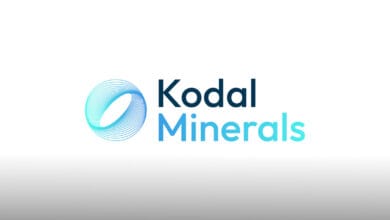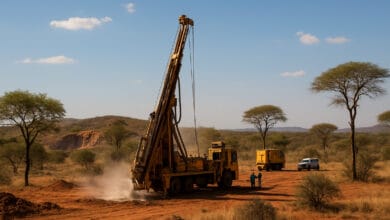The Haib Copper Project in Namibia’s ǁKaras Region is set to produce between 35,000 and 40,000 tonnes of copper annually in combined concentrate and cathode form, according to Koryx Copper Inc.’s Preliminary Economic Assessment (PEA) filed on 8 October 2025 on SEDAR+.
The study positions Haib as a technically advanced, cost-efficient operation capable of delivering strong returns over a projected 23-year mine life.
The PEA outlines a dual-stream processing model combining a conventional 8 million tonnes per annum (Mtpa) concentrator for higher-grade sulphide ore with a 17 Mtpa heap-leach hydrometallurgical plant for lower-grade material.
Together, the circuits will process approximately 25 Mtpa of ore, supported by an open-pit mining operation targeting copper grades ranging from 0.3% to 0.5% Cu.
From these processing routes, Koryx expects average annual production of 38,000 tonnes of copper, delivering a post-tax NPV (8%) of US$1.35 billion (approximately N$25.2 billion) and an internal rate of return (IRR) of 35%.
The payback period is estimated at just 3.5 years, underlining Haib’s economic resilience even in moderate price scenarios.
The capital cost to develop the project is estimated at US$340 million (N$6.4 billion), covering plant construction, mining infrastructure, power, and water supply.
Sustaining capital is projected at US$100 million over the life of mine, while pre-production costs for feasibility, permitting, and early works are pegged at around US$15–20 million.
Operating costs are forecast at US$1.28 per pound of copper, placing Haib within the lower half of the global cost curve for porphyry operations.
This cost advantage is driven by high throughput, low strip ratios (0.56:1), and Namibia’s favourable mining infrastructure.
What Koryx has put on the record is an updated PEA filed on October 8, 2025, outlining a 23-year operation with an average of roughly 92,000 tonnes of payable copper per annum in the first decade and strong project economics, but no calendar start date.
The company says it expects to complete ongoing infill and expansion drilling, resource updates, and mine planning in the first half of 2026, followed by definitive feasibility, permitting, and financing steps – again, without giving a specific first-production year.
Practically, that means first copper will depend on how quickly Koryx secures approvals and funding after the 2026 study work.
Under the current PEA schedule, construction and commissioning are expected to take 24 to 30 months from the final investment decision, with the heap-leach circuit and SX-EW plant expected to deliver first copper cathode production in Year 3, while the concentrator will be commissioned roughly six months later, bringing Haib to full output by Year 5 (2028).
Test work conducted by Maelgwyn Mineral Services, Mintek, and Ceibo confirmed recoveries of up to 87% from flotation and 65% from heap leach, validating the project’s metallurgical design.
The flowsheet’s flexibility enables consistent output, even with grade variability, ensuring long-term production stability.
With its combination of scale, strong economics, and modern processing technology, Koryx Copper’s Haib Project stands out as a flagship copper development in southern Africa – one capable of generating sustained revenues, supporting Namibia’s green industrialisation goals, and contributing vital supply to the global energy transition.









